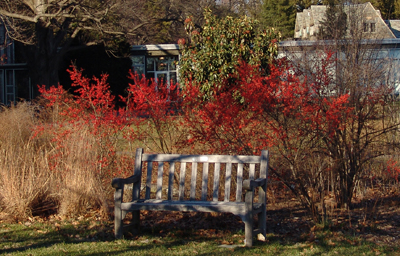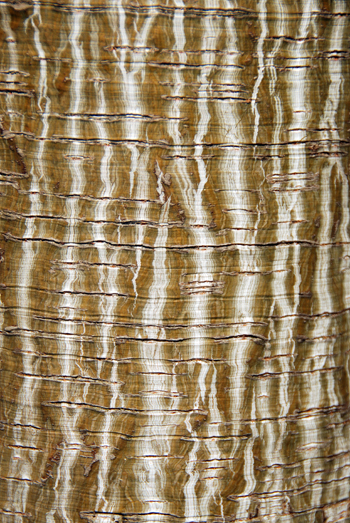Acer pensylvanicum ‘Erythrocladum’

I have really been feeling the transition of the seasons lately. Leaves are dropping along with the temperature, everyone seems to be under the weather, and certain plants are popping out among the flat landscape. Here at the Scott Arboretum, however, there is never a dull moment, and several plants are vying for attention.

Ilex ''Sparkleberry' in the BioStream. photo credit: R. Robert
The winterberries keep catching my eye, especially the mass plantings of Ilex verticillata ‘Winter Red’ and ‘Winter Gold’. The ‘Winter Red’ cultivar has always been one of my favorite shrubs, with its powerful display of thick red clusters of berries that are very persistent. My nose has also become captivated by the fragrant wintersweet, Chimonanthus praecox ‘Luteus’. It is exhilarating to catch such a pungent scent while everything else appears lifeless.

Ampelaster carolinianus. photo credit: R. Maurer
Finally, another plant worth mentioning is the climbing aster, Ampelaster carolinianus , which is hidden within the Pollinator Garden. Horticulturist Chuck Hinkle is responsible for planting this exciting late bloomer. It was full of personality in the midst of a wind storm! It blooms this time of year with quarter-sized lavender flowers with yellow centers. These are just of a few of my favorite performers this month, but my top choice is Acer pensylvanicum ‘Erythrocladum’ planted right outside of the Cunningham House.

The fascinating bark of Acer 'White Tigress'. photo credit: S. Keitch
Lately I have been taking the time to notice the subtlety of plants, and the more I inspect the different snakebark maples, the more I appreciate their intricacy. Hiking along the pathway behind the Lang Performing Arts Building, it is hard to notice the old maples tucked among the understory. Acer davidii , A. rufinerve, A. grosseri var. hersii, and A. capillipes can all be found in this small area. Another gorgeous mature specimen is Acer ‘White Tigress’, which hovers over a large portion of the hydrangea collection. This is believed to be a hybrid of Acer davidii and Acer tegmentosum.

The white stripes on Acer pensylvanicum 'Erthrocladum'. photo credit: S. Keitch
All of these species have such fascinating bark evolutions. As their bark matures it becomes embellished with vertical white stripes. There is considerable variation among the species, but my favorite color patterns are of juvenile Acer davidii. The bark of the ‘Erythrocladum’ however, turns from a tan or orange tone to an impressive hot red during the winter. The red and white pattern is almost reminiscent of holiday candy. From a distance the young tips of the tree appear pure coral red, which beckons pedestrians for a closer look. Spectacular fall color, as well as delicate yellow flowers in the spring, provides this selection with ornamental appeal throughout the seasons. This native striped maple only reaches a modest ten to twenty feet, making it an ideal specimen for tight locations.

Brillantly red branches of Acer pensylvanicum 'Erythrocladum'. photo credit: S. Keitch
Acer pensylvanicum is the only native snakebark species, and is a questionable addition to a garden, but the ‘Erythrocladum’ variety is positively exquisite. Most of these small trees are considered short lived, but they are well worth the investment. They are nice compact plants that should be planted along walkways in order to expose pedestrians to the fine details of their bark. I encourage everyone to stop by the Arboretum office and take a moment to closely inspect this fiery wonder.





No Comments